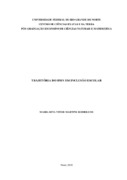Use este identificador para citar ou linkar para este item:
https://repositorio.ufrn.br/handle/123456789/16064| Título: | Trajetória do IFRN em inclusão escolar |
| Autor(es): | Rodrigues, Maria Rita Vitor Martins |
| Orientador: | Silva, Márcia Gorette Lima da |
| Palavras-chave: | Núcleo de apoio;Deficientes visuais;Inclusão na escola;IFRN;Support unit;Visually handicapped;School inclusion;IFRN |
| Data do documento: | 6-Mai-2010 |
| Editor: | Universidade Federal do Rio Grande do Norte |
| Referência: | RODRIGUES, Maria Rita Vitor Martins. Trajetória do IFRN em inclusão escolar. 2010. 100 f. Dissertação (Mestrado em Ensino de Ciências Naturais e Matemática) - Universidade Federal do Rio Grande do Norte, Natal, 2010. |
| Resumo: | As discussões sobre inclusão de pessoas com necessidades especiais na escola são relativamente recentes, mas toma corpo no âmbito internacional e nacional. Por outro lado, tal discussão aos poucos vem se incorporando nos discursos e ações na instituição escolar e, mais ainda na formação dos docentes. Esta investigação parte da necessidade de levantar elementos para (re)pensar as ações propostas para inclusão de jovens com necessidade educativa especial, neste particular com deficiência visual (DV), no Instituto Federal de Educação, Ciência e Tecnologia do Rio Grande do Norte (IFRN). Como apoio principal para as ações da instituição encontra-se a criação do núcleo de apoio. Intenciona-se conhecer a voz de jovens com DV para que as suas experiências possam sinalizar os caminhos e descaminhos tomados pelo núcleo de apoio. Assim, neste relato a experiência vivenciada por estes jovens é de fundamental importância. Para tanto, optou-se por utilizar elementos metodológicos apoiados na história de vida de dois alunos com DV, aqui chamados de aluno (A1) e aluno (A2), desde a infância até a entrada no IFRN. Deste relato emergiram como categorias: a infância e o papel da família; a trajetória escolar e, por fim, relativas às ações do núcleo de apoio do IFRN, dividindo-se em atitudes inclusivas e obstáculos. A primeira resgata as ações da família no processo de ensino e aprendizagem destes alunos. A segunda categoria apresenta o momento em que os alunos começaram a receberem a educação formal, propriamente dita. A última categoria constitui o ponto fundamental da investigação, pois analisa o processo de inclusão na instituição, na percepção dos próprios estudantes com deficiência visual. Os resultados sinalizam para a necessidade de ações partilhadas entre alunos com NEE e profissionais da escola na elaboração do Plano Educacional, que garantam a defesa dos direitos a uma prática pedagógica eficiente e eficaz no processo de inclusão desses alunos |
| Abstract: | Discussions over the topic of inclusion of handicapped people at school are considered recent, but they have become more and more frequent within the national and international scenario. Such discussion has also being inserted in the speeches and actions of the school institution and with the formation of educators. This investigation is made necessary as a way to collect elements to reconsider the actions for the inclusion of the special education need youth. In special the visually handicapped ones, at Instituto Federal de Educação, Ciência e Tecnologia do Rio Grande do Norte (IFRN). The creation of a support unit functions as main vehicle for the actions of the institution. It is intended to know what young people with limitations have to say regarding their experiences as a way to signal paths to be and not to be followed by the support unit. Therefore, the experience which these young boys and girls have is of crucial importance. In order to accomplish the task, it was decided to use methodological elements based upon elements supported by the life reports of two deficient students here called Borges and Stéfano. Their reports are from childhood to their arrival at IFRN. From their reports, categories appeared: childhood and the role of family; school life and, finally, related to the actions of the support unit of IFRN, being divided in inclusive actions and obstacles. The first one takes a second look at the actions of the family within the learning-teaching process of these students. The second category presents the moment in which students started to receive formal education per se. The last category constitutes the cornerstone of the investigation, for it analyses the process of inclusion in the institution, according to the perception of the students with visual limitations. The results signaled the need for shared intervention between students with Special Education Needs and school professionals in the elaboration of the Educational Planning, which guarantees the defense of the rights to an efficient teaching practice and effective in the process of inclusion of these students |
| URI: | https://repositorio.ufrn.br/jspui/handle/123456789/16064 |
| Aparece nas coleções: | PPGECNM - Mestrado em Ensino de Ciências Naturais e Matemática |
Arquivos associados a este item:
| Arquivo | Descrição | Tamanho | Formato | |
|---|---|---|---|---|
| MariaRVMR_DISSERT.pdf | 1,6 MB | Adobe PDF |  Visualizar/Abrir |
Os itens no repositório estão protegidos por copyright, com todos os direitos reservados, salvo quando é indicado o contrário.

